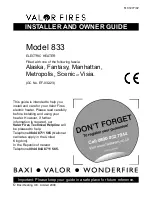
CONNECTIONS – PLUMBING
33
EXPANSION CONTROL VALVE
Local regulations may make it mandatory to install an expansion control valve (ECV) in the cold water line to
the water heater. In other areas, an ECV is required if the saturation index is greater than +0.4 (refer to
on page 18).
The expansion control valve must always be installed after the non-return valve and be the last valve installed
prior to the water heater (refer to the
on page 31). A copper drain line must be
fitted to the expansion control valve (refer to
on page 33).
The valve, if installed within 500 mm of the water heater, must be insulated with closed cell polymer insulation
or similar (minimum thickness 9 mm) and the insulation installed so as not to impede the operation of the valve.
The insulation must be weatherproof and UV resistant if exposed.
RELIEF VALVE DRAIN
DN15 copper drain lines must be fitted to the temperature pressure relief valve and expansion control valve (if
one is installed) to carry the discharge clear of the water heater. Connect the drain lines to the valves using
disconnection unions. The drain line from the valve to the point of discharge should be as short as possible,
have a continuous fall all the way from the water heater to the discharge outlet and have no tap, valves or
other restrictions in the pipe work. A drain line from a relief valve must comply with the requirements of
AS/NZS 3500.4.
A drain line must be no longer than nine (9) metres with no more than three bends greater than 45° before
discharging at an outlet or air break. The maximum length of nine (9) metres for a drain line is reduced by
one (1) metre for each additional bend required of greater than 45°, up to a maximum of three additional bends.
Where the distance to the point of final discharge exceeds this length, the drain line can discharge into a
tundish.
Subject to local regulatory authority approval, the drain lines from the temperature pressure relief valve and
expansion control valve from an individual water heater may be interconnected.
The outlet of a drain line must be in such a position that flow out of the pipe can be easily seen, but arranged
so discharge will not cause injury, damage or nuisance. The termination point of a drain line must comply with
the requirements of AS/NZS 3500.4. Drain lines must not discharge into a safe tray.
In locations where water pipes are prone to freezing, drain lines must be insulated, must not exceed 300 mm
in length and are to discharge into a tundish through an air gap of between 75 mm and 150 mm.
If a drain line discharges into a tundish, the drain line from the tundish must be not less than DN20. The drain
line from a tundish must meet the same requirements as for a drain line from a relief valve.
Warning:
As the function of the temperature pressure relief valve on this water heater is to discharge high
temperature water under certain conditions, it is strongly recommended the pipe work downstream of the relief
valve be capable of carrying water exceeding 93°C. Failure to observe this precaution may result in damage
to pipe work and property.
Содержание 250E5X
Страница 39: ...39 This page is intentionally blank ...








































